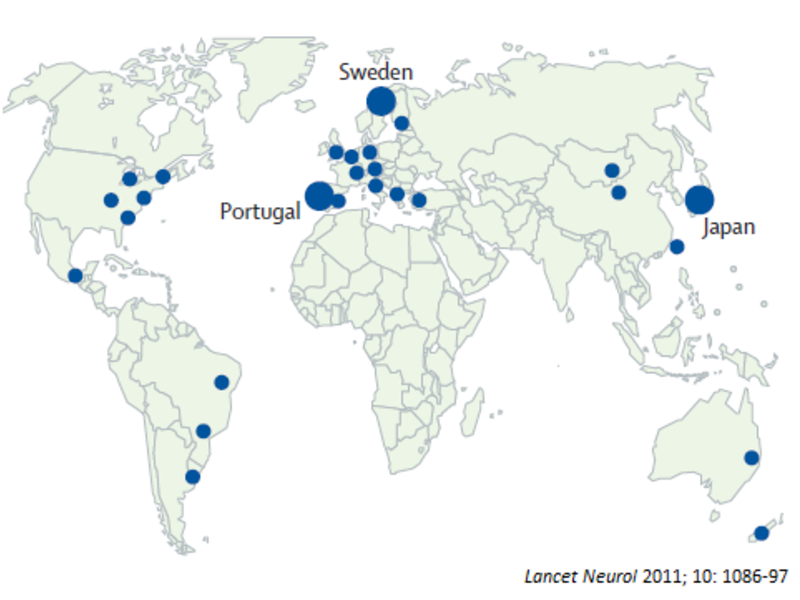ATTR Amyloidosis
Transthyretin (TTR) is a biologically-conserved protein involved in transport and neuroprotective functions in the blood and cerebral spinal fluid. TTR is also implicated in the formation of amyloid aggregates and fibrils in different tissues and organs, causing severe and progressive pathologies associated with high morbidity, disability and early passing.
Hereditary ATTR with polyneuropathy
Hereditary TTR amyloidosis with polyneuropathy (hATTR-PN), also known as Familial Amyloid Polyneuropathy (TTR-FAP), is caused by the formation of TTR amyloid in the peripheral nervous system, causing sensory, motor and autonomic dysfunction, resulting in significant disability and death.
The early somatic symptoms of peripheral neuropathy often include:
- numbness and tingling in the lower limbs
- decreased sensation to pain and temperature in the limb
- pins and needles sensation in the feet and hands
- weakness and pain in the arms and legs
The autonomic neuropathy is responsible for:
- postural hypotension
- disturbed bowel function
- urinary retention
- sexual dysfunction
- reduced sweating
hATTR-PN affects approximately 10,000 people worldwide, with high prevalence in endemic regions such as Portugal, Sweden and Japan. However, there are worrying indications of underdiagnoses in regions such as Brazil. The most common type of hATTR-PN is caused by the V30M variant of TTR.
Ocular manifestations in ATTR
The incidence of amyloid deposition on the lens and vitreous and vascular abnormalities of the conjunctiva and retina significantly increases as hATTR-PN progresses.
The ocular symptoms often include:
- dry eye
- opacification of anterior capsule lens
- scalloped iris
- vitreous amyloidosis
- glaucoma
- retinal amyloidotic angiopathy
- conjunctival microaneurysms
At present, the therapeutic approaches for ocular manifestations of hATTR-PN are directed to the symptoms. No disease modifying therapy is available, thus making this is an unmet medical need.
Central nervous system manifestations in ATTR
Clinical manifestations associated with the Central Nervous System (CNS) occurs in hATTR-PN patients, normally long periods after disease onset.
The most common manifestations include:
- focal neurological episodes (FNEs)
- cerebral amyloid angiopathy
- brain hemorrhages and microstrokes
At present, this is an unmet medical need.
Hereditary ATTR with cardiomyopathy
Hereditary TTR amyloidosis with cardiomyopathy (hATTR-CM), also known as Familial Amyloid Cardiomyopathy (TTR-FAC), is caused by the accumulation of TTR amyloid primarily in the heart, causing restrictive cardiomyopathy, heart failure and eventually death.
Usually, there is no nervous system involvement in hATTR-CM, and the symptoms include:
- shortness of breath
- palpitations and abnormal heart rhythms (atrial fibrillation)
- leg swelling
- weight loss
- fatigue
- insomnia
- dizziness
- angina
Carpal tunnel syndrome, characterized by pain and tingling in the wrists and hands, often appears several years before heart disease.
hATTR-CM is diagnosed in approximately 40,000 people worldwide, but there are estimates suggesting it may affect more than 200,000 people. TTR V122I is the most common TTR variant implicated in hereditary amyloid cardiomyopathy, present in almost 3 million African Americans.
Non-hereditary wildtype ATTR
Wild-type TTR amyloidosis (wtATTR), also known as Senile Systemic Amyloidosis (SSA), is a slowly progressive disorder, more common in men than in women, not hereditary, caused by amyloid deposits of normal TTR, mainly in the heart.
Main symptoms include:
- nausea
- weight loss
- insomnia
- shortness of breath, increasing fatigue, dizziness
- leg swelling (edema)
- palpitations and abnormal heart rhythms (atrial fibrillation)
- chest pain
wtATTR is present in ca. 80% of males over 80 years old, of which ca. 25% experience symptoms.
